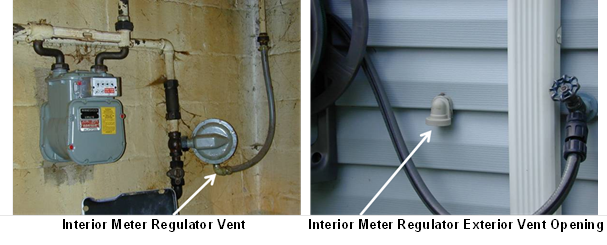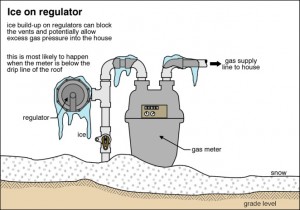This week I was reminded of how dangerous this time of year can be in the northern states. With snow and ice thaw and then re-freeze, gas meters become a very BIG safety concern.
Who looks at their gas meter?
The answer is nobody…unless there’s a problem. Every year MN home inspectors come across frozen or snow blocked gas meters. Frankly, unless this condition is corrected a seasoned home inspector wouldn’t enter a home until this condition is fixed. It’s simply too dangerous!
In Minneapolis, St. Paul, and most all communities, there are two locations for natural gas meters. The older meters are located inside the house and obviously do not present themselves as a winter concern. Not so fast, if these interior meters have a regulator, this must be vented to the outside of the home.

A regulator on a gas meters indicates the local utility is supplying the house with high pressure gas. Are you beginning to get the picture? Is the house speaking to you? High pressure gas needs to be vented to the outside of the building. If the vent pipe is blocked by a pile of snow, oh my, this could be a MEGA problem.
 Modern meters are installed on the outside of the home. There are good and bad locations for these meters. For example they shouldn’t be under the drip line of a roof or in areas that accumulate piles of snow. In these situations the meter regulators could become buried or frozen. When blocked, there is a good chance that gas fumes could build up and an explosion could occur.
Modern meters are installed on the outside of the home. There are good and bad locations for these meters. For example they shouldn’t be under the drip line of a roof or in areas that accumulate piles of snow. In these situations the meter regulators could become buried or frozen. When blocked, there is a good chance that gas fumes could build up and an explosion could occur.
So go outside today and check out your meter or the vent opening and verify the snow and ice has not blocked it.
Be safe…
Doug Hastings
MN Home Inspector
Minneapolis & St. Paul
Kaplan University
Home Inspection Lead Instructor




